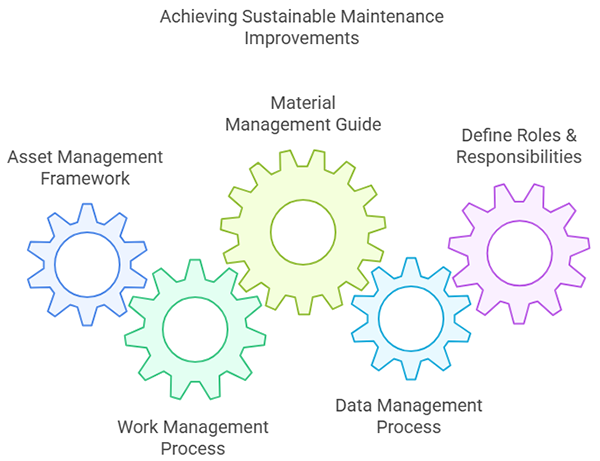Have you ever woken up and not wanted to go to work? Some days, you just don’t feel like working.
Busy work is not the same as productive work.
I have. Those were the longest days of my life. All I had to do was look busy because my boss thought I was busy if I looked busy. Do you know what I wound up doing all 25 hours of my eight-hour shift? Looking at my watch what seemed like every 42 seconds.
Those days were the worst because I was not being fully utilized. I didn’t have enough maintenance work to keep me busy for the full eight hours.
Truthfully, a good day for me was when I put in a full day of activity. Before I knew it, it was time to go home and crack a beer. I spread the blame for my situation. I blame myself for not being more motivated, the maintenance planner and scheduler for not scheduling enough work to keep me busy, and my supervisor for not supervising.
The Impact of Poor Planning on Technician Productivity
As managers, it ultimately comes down to how well we manage our resources and their utilization. Effective maintenance planners can significantly impact an organization’s bottom line, yet many companies don’t pay adequate attention to this role.
Without proper planning, technicians spend almost half their day on non-value-added tasks.
With 18 percent of a typical maintenance technician’s day spent looking for parts and 24-26 percent walking to and from the job site, technicians can waste almost 50 percent of each day doing activities that do not add value to their organizations. I’ve written several articles on this topic and the financial impact that maintenance planners have on an organization.
Two activities have the potential to increase technicians’ wrench time by 50 percent: planning maintenance work and kitting for planned maintenance work.
Implementing these two activities means maintenance technicians no longer have to plan their own jobs, which brings consistency, and they no longer have to spend time looking for parts and tools because these materials have been kitted and are ready for the planned job.
Key Strategies to Increase Wrench Time Efficiency
I shared a case study about the financial impact of poor technician utilization some time back. In that instance, the utilization rate of a 22-person maintenance group was 18.7 percent.
This utilization rate was equivalent to having 15 full-time equivalent (FTE) technicians sit around all day doing nothing while the other seven technicians did all the work. More importantly, the average hourly rate of $42.25 per hour based on that utilization rate was costing the company $285 per hour to complete the maintenance activities.
A well-structured maintenance plan can double direct technician hours and cut costs significantly.
After moving two technicians into the department’s planner role and implementing kitting procedures, utilization improved to 42.6 percent in a very short time, thereby reducing the average labor rate from $285 per hour to $123 per hour.
The department doubled the direct technician hours available, and it reduced inventories by 19.8 percent because work was being planned well in advance, and procurement could buy materials at regular lead times instead of having the materials expedited.
Supervisors also were formally trained to be more involved in technician activities, removing obstacles and managing people rather than writing reports and fighting fires.
Addressing Structural Weaknesses in Maintenance Management
Recently, I worked with an organization and found the following:
- The department had a high turnover ratio and no formal engineering group.
- Supervisors functioned as the maintenance planners, and scheduling was done the afternoon before the following day.
- Supervisors were not planning any work, which meant the technicians were repairing assets on the fly without documentation of work performed.
- The department was not prioritizing corrective maintenance. As a result, 81 percent of corrective work orders were marked as needing to be completed within 48 hours, while 13 percent were marked as needing to be completed within 24 hours.
- A work management assessment determined that the utilization rate was below 12 percent.
- Inventories were bloated. As a result, fees for expedited orders outpaced the actual cost of the materials.
Building a Framework for Sustainable Maintenance Improvements

The report to senior leadership on the situation recommended the following actions to shore up the deficiencies:
Asset Management Framework
This step focuses on a holistic reliability-based asset optimization strategy — failure mode, effects and criticality analysis, maintenance strategies, PMs, etc.
Work Management Process Guide
This recommendation refers to the entire work management process to identify, plan, execute, closeout, and analyze.
Material Management Process Guide
This recommended set of processes is designed to identify material requirements, procurement and provisions for the materials to be available at the right time at the right place.
Data Management Process Guide
This recommendation provides a process with roles and responsibilities for managing critical data related to hardware breakdown structures and bills of material, as well as for managing and maintaining data quality.
Clearly Defined Roles and Responsibilities
This recommendation involves restructuring the entire maintenance department. Supervisors supervise and establish a formal planning department that includes schedulers. They also re-assign identified resources to predictive maintenance strategies and development.
Putting Plans into Action to Increase Technician Productivity
Leadership took the findings and recommendations to heart. Six months after receiving the report, they restructured the maintenance organization. The department has one maintenance manager responsible for the group — four supervisors, four planners, and two schedulers.
A weekly scheduling meeting locks in efficiency and prevents last-minute chaos.
They also established a weekly scheduling meeting to lock in a week. This step allows the storeroom personnel to kit planned activities and PMs. They are in the process of writing process guides to refine the work management procedures further. They have also completed a review of the CMMS configuration, updated status codes, and failure codes, and completed backlog cleanup.
The results are promising, and the culture change was almost immediately recognizable when I returned — a far cry from where it was just a few months ago. The turnover ratio has declined, and maintenance is no longer a dirty word in the organization.
The case studies demonstrate that organizations have made a leap of faith in making significant changes to the current state of maintenance activities.
The organizations also supported these changes with a heavy dose of change management principles, which most organizations underestimate. These actions significantly improved the efficiency and effectiveness of maintenance activities. Furthermore, costs decreased, and the bottom line improved.
I’m willing to bet that folks at these two organizations feel a greater sense of accomplishment and contribution because they know they are making a difference instead of just coming to work to look busy.











